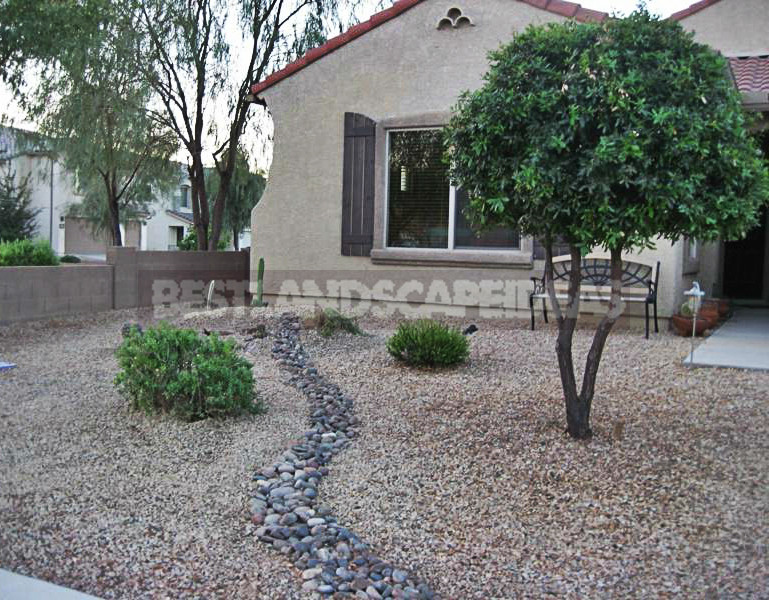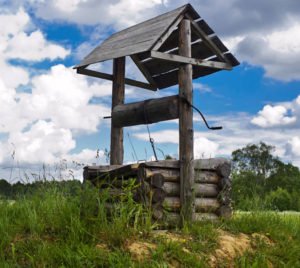
Decorative gravel gardens have been created in European parks for a long time. Gardeners used gravel not only to decorate garden paths and flower beds, but also to decorate various recreation areas. Most often, such sites were the center of the composition: the site in the middle was filled with gravel, and a large decorative object was installed in its center – a beautiful sculpture or, for example, a chic fountain.

Gravel gardens in the East were and still are even more popular than in Europe.

Perhaps today there is no person who has not heard about the “Japanese rock gardens– – symbols of the harmony of the universe. The center of such compositions is often a gravel platform, which is a water surface dotted with all sorts of concentric circles and many parallel lines.
So why don’t we use the wisdom of the East and the experience of European gardeners to decorate our gardens with a unique natural material — gravel?
Due to the diverse size and color of gravel, as well as the richness of its shapes, you can create unique garden compositions with various effects. The sun in the yard is either cloudy, foggy or raining, it is always different and always unique, it surprises and conquers, forever remaining in the memory of everyone who had the opportunity to contemplate this man-made miracle.
Gravel, like any natural material, has its advantages and disadvantages, let’s try to figure them out together.
The advantages of gravel
Ecological compatibility
The main advantage of gravel is its environmental friendliness. Properly laid gravel will never prevent the soil from absorbing water. In addition, it does not interfere with the access of soil air, so that the roots of plants under it will not lose their viability. Gravel is not only an excellent background for most plants used on alpine slides, but also an excellent mulching material – thanks to its ability to cool the soil on hot days.

Decorativeness
Gravel can serve as an excellent substitute for a grassy lawn or paving the yard with tiles. Due to its stable decorative effect, this unique natural material perfectly sets off the beauty of various garden plants, emphasizing and complementing it. In addition, unlike various plantings, a gravel garden landscape is not subject to the vagaries of the weather, and therefore will always look equally good, both after heavy rain and after hail. Decorative gravel allows you to arrange a beautiful composition where planting various ornamental plants is impractical or simply impossible — on poor soils and rocky terrain, in humid areas and in arid climates.
In addition to ordinary gravel, which is extremely decorative in itself, there is a special decorative gravel, which can be different in color: red, white, gold, black, purple, blue, green, orange, pink, etc.

Decorative gravel is its size. So, to create a gravel garden at the same time, you can use both very small, with a diameter of about 8 mm, and sufficiently large, about 75 mm in diameter, gravel.

Perfect compatibility
Another indisputable advantage of gravel is its compatibility with various plants and other decorative materials. Gravel is equally well combined with huge boulders and wood, glass and metal, moss and concrete, which allows you to create unusual and amazing compositions.

Gravel-an indispensable material for decorating problem areas
With the help of gravel, you can easily equip various problem areas on the garden plot: inconveniently located hills or depressions of irregular, complex shape, which are always the subject of dissatisfaction of the owners. The problem is that the possibilities for planting in such places are very limited, and I really want to create beauty in every corner of my garden.
They are most suitable for a gravel garden and shady areas of the garden, in which the arrangement of a lawn or flower beds is simply impossible. And this means that any, even the most unsightly part of your garden can become its unique “highlight”. For example, using gravel and shade-loving flowers, you can create a bright and expressive composition in the shade of your garden.

Easy to care for and practical
The gravel garden is not demanding in care, you will have to work only once – in the process of its creation. In addition to the ease of care, gravel is also a very practical inexpensive material, so to speak, an affordable way to create a unique garden. In addition, working with gravel does not require any special skills from you. Even if you don’t know anything about garden design, believe me: a little effort — and a composition of gravel will be a wonderful decoration of your garden plot. Just do not limit your imagination, use colored gravel of different fractions, lay out different patterns, combine it with large boulders, sand, pebbles and even glass chips.
Excellent material for simulation
Many gardeners dream of creating a pond on their plot, but this is not always possible: the plot area is too small, its location does not allow. It is in such cases that a gravel garden will come to the rescue, which will be an excellent imitation of a reservoir.
In addition, using gravel, you can successfully simulate other landscape natural conditions: pebbles and shells depict the seashore, yellow sand and orange gravel – desert, blue – stream, red – lava.

How can gravel be used in the garden?
Considering that working with gravel does not require special skill, anyone can decorate their garden plot with it, the main thing is desire. Fine gravel can simply be poured around large plants, creating such a composition, you will not only decorate your garden, but also benefit plants – gravel will help to retain moisture in the soil. And you can create a gravel garden out of gravel, and I’ll tell you how to do it now.

Creating a gravel garden
The first step in creating a gravel garden is to choose a plot, having decided on which, you can proceed to the drainage device. But before you do this, the site must be carefully cleaned. After cleaning, the entire area is treated with a herbicide intended for a gravel garden, then drainage and tightly packed earth. Directly under the gravel, with the help of pre-prepared wire staples, a geotextile or film litter is attached, in which holes are made for subsequent planting. Moreover, the area covered with geotextile should be slightly larger than the area of the plot on which the gravel garden is arranged.

During the construction of a gravel garden, do not forget about plants that are traditionally selected according to the parameters of “unpretentiousness” and decorative. Saxifrage, yarrow, wormwood, phlox, rosehip, thyme and others will look especially impressive against the background of gravel.

It is impossible to do in a gravel garden without low-growing shrubs: lapchatki, Japanese spirea, single-leaved magonia, whose leaves also retain their decorative effect for a long time.
After the geotextile is fixed, it is necessary to plant the plants.
Planting plants in the gravel garden
Open the edges of the geotextile cut across, wrapping them so as to form a square window. In this window, dig a hole, replacing the soil with a more fertile one. Having properly fertilized the soil in the hole, carefully place the plant in the hole and bury it. Once the plants are planted, you can fill the remaining space on the plot with gravel. We begin to fall asleep from the most inaccessible areas, a layer of gravel about 5 cm (2 in). Before laying, it is advisable to rinse with running clean water – the only way weeds will not start on it for a long time.

Dividing borders made of metal or plastic (about 20 cm/7.9 in high) will help you a lot. These curbs will not blur the boundaries of the gravel area, will keep the composition in pristine purity and beauty. As a curb, you can use ordinary boards pre-treated with a special anti-rot agent. A good fence-curb will be made of brick, but it is better not to make a curb out of thin sheet iron and slate – the probability of injury is too high.

To do this, delineate the boundaries of the track with the help of securely installed curbs, the inner space of the track is filled with a layer of ordinary sand (about 15 cm/5.9 in), a layer of construction gravel (also about 15 cm/5.9 in) and only after that a 10-centimeter (3.9 in) layer of any decorative gravel, the fraction of which does not exceed 1 cm (0.4 in).Having tightly laid all the layers, carefully pour the path with ordinary water and carefully tamp it, enjoy its unique, ideal look. If you decide to create a gravel path in the garden, keep in mind that for every meter of such a wonderful path, which is 1 m (3.3 ft) wide and 10 cm (3.9 in) high, you will need about 200 kg (441 lb) of gravel.

Agree, thanks to such a decorative and unique material as gravel, there is a place to run wild – you can experiment not only with color, but also with fraction, create unique patterns and even change the relief of the garden plot. With a little effort, decorating your garden with decorative gravel, you will make it unusual and original.
I will be very glad if the information about the use of gravel in the garden will be useful for you and with its help you will be able to create a miracle in your garden — another beautiful corner.




Leave a Reply